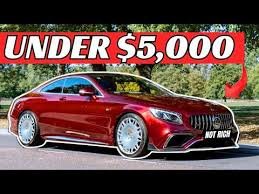Muscle Car: A Comprehensive Exploration of the Iconic American Legend
The muscle car is an icon of American automotive culture, a symbol of power, performance, and rebellious spirit. These cars have become synonymous with raw speed, aggressive design, and an unrelenting pursuit of the thrill of driving. With their powerful engines, distinct styling, and storied history, muscle cars have captivated automotive enthusiasts for decades and continue to be a source of admiration, nostalgia, and passion.
In this article, we will explore the origins, evolution, and cultural significance of muscle cars, delving into the reasons why they remain one of the most beloved and enduring segments of the automotive world. From their roots in the post-World War II era to their impact on popular culture and their status as modern-day performance machines, muscle cars represent much more than just a category of vehicles—they are a celebration of American engineering, design, and automotive heritage.

What Is a Muscle Car?
A muscle car is typically defined as a high-performance, V8-powered vehicle that emphasizes speed, acceleration, and aggressive styling. These cars are known for their large engines, often 6.0 liters or more, and their focus on straight-line speed, rather than handling or luxury. Muscle cars are characterized by:
- Powerful Engines: Muscle cars are often equipped with large V8 engines that deliver impressive horsepower and torque. These engines are built for speed, with an emphasis on raw performance.
- Aggressive Styling: Muscle cars feature bold, muscular designs with wide hoods, flared wheel arches, and distinctive front grilles. Their appearance is meant to convey strength and power, reflecting the car’s performance capabilities.
- Affordability: Unlike supercars, which are out of reach for most people due to their exorbitant prices, muscle cars were originally designed to be relatively affordable, making high-performance driving accessible to a wider audience.
- Performance-Oriented: Muscle cars are designed for quick acceleration, high top speeds, and an exhilarating driving experience. While they may not always have the precision handling of a sports car, they excel in raw power and engine performance.
The Birth of the Muscle Car: 1940s to 1960s
The origins of the muscle car can be traced back to the post-World War II era, a time of rapid technological advancements and economic prosperity in the United States. Automakers were eager to create vehicles that combined performance with style, and a growing demand for powerful cars among American consumers provided the perfect opportunity.
- The Early Years: The 1940s and early 1950s saw the development of several precursor vehicles that laid the groundwork for the muscle car. The 1949 Oldsmobile Rocket 88 is often credited as one of the first true muscle cars. With a V8 engine and a lightweight body, the Rocket 88 offered a combination of performance and affordability that caught the attention of driving enthusiasts.
- The Golden Age of Muscle Cars: The 1960s marked the true birth of the muscle car, as manufacturers began to push the boundaries of performance with ever-larger engines. Automakers like Ford, Chevrolet, Pontiac, and Dodge started producing cars that combined massive V8 engines with sleek designs and aggressive styling. These cars were designed for the growing market of young, thrill-seeking drivers who craved speed and excitement.
- Ford Mustang (1964): The Ford Mustang is widely considered to be the car that ignited the muscle car revolution. Released in 1964, the Mustang quickly became a cultural phenomenon. It combined a sleek design, affordable price, and powerful engine options, appealing to a wide range of consumers. The introduction of the Mustang GT in 1965, with its V8 engine and enhanced performance, cemented the Mustang’s status as a true muscle car.
- Chevrolet Camaro (1967): In response to the Mustang’s success, Chevrolet introduced the Camaro in 1967. The Camaro was designed to compete directly with the Mustang, offering a range of powerful engine options and a stylish, aggressive design. The Camaro quickly became a favorite among muscle car enthusiasts and remains one of the most iconic American performance cars.
- Dodge Charger (1966): The Dodge Charger was another standout of the muscle car era, known for its bold styling and powerful engines. The first-generation Charger, introduced in 1966, featured a long, sleek body and a range of V8 engine options. The Charger would go on to become a staple of American muscle car culture, particularly in its later, more powerful iterations.
- Pontiac GTO (1964): The Pontiac GTO is often credited with being the first true muscle car. The GTO was introduced in 1964 as an option package for the Pontiac Tempest, featuring a 389-cubic-inch V8 engine. The GTO’s combination of power, performance, and affordability made it an instant success, and it helped define the muscle car segment.
The Golden Age of Muscle Cars (1960s-1970s)
The 1960s and early 1970s represent the golden age of muscle cars, with automakers pushing the limits of engine performance and design. During this time, muscle cars were the pinnacle of American automotive engineering, and the rivalry between brands like Ford, Chevrolet, and Dodge reached its peak.
- Performance Rivalries: The muscle car era was marked by intense competition between automakers to create the most powerful and fastest cars. Ford’s Mustang faced off against Chevrolet’s Camaro, while Dodge’s Charger competed with Plymouth’s Road Runner. The performance figures of these cars were often astonishing, with many of them offering more than 400 horsepower and acceleration times that rivaled exotic sports cars.
- Iconic Models: Some of the most iconic muscle cars of all time were produced during this period. The Chevrolet Chevelle SS, the Pontiac Firebird, the Shelby GT350 Mustang, and the Dodge Challenger were just a few of the legendary models that defined the era. These cars were designed to offer blistering acceleration, high top speeds, and a driving experience that was unlike anything else on the road.
- The 1970s Muscle Car Crisis: While the muscle car era reached its peak in the late 1960s and early 1970s, the rise of stricter emissions regulations and the oil crisis of 1973 led to a decline in muscle car production. Automakers were forced to reduce engine sizes and increase fuel efficiency, leading to the end of the golden age of muscle cars. By the mid-1970s, many of the classic muscle cars had been discontinued or drastically toned down in terms of performance.
The Decline and Revival of Muscle Cars (1980s to 2000s)
After the muscle car crisis of the 1970s, the segment experienced a significant decline in popularity. However, muscle cars never disappeared entirely, and by the 1980s and 1990s, there was a resurgence of interest in high-performance American vehicles.
- The 1980s: During the 1980s, the muscle car market was largely overshadowed by the rise of compact, fuel-efficient vehicles and the growing popularity of imports. However, some muscle car models continued to be produced, albeit with less power than their predecessors. The Chevrolet Camaro and Ford Mustang continued to be available, but they were equipped with smaller, less powerful engines in response to fuel efficiency and emissions concerns.
- The 1990s and Early 2000s: In the 1990s, muscle cars began to regain some of their former glory. The Ford Mustang, in particular, underwent a redesign in 1994 that brought it back to its roots, with a focus on performance and style. The introduction of the Dodge Viper in 1992 and the Chevrolet Corvette continued to showcase American performance capabilities, although these vehicles were more aligned with the sports car category.
- The Revival: The true revival of the muscle car came in the early 2000s with the introduction of new models that paid homage to the classic muscle cars of the 1960s and 1970s. The 2005 Ford Mustang, with its retro-inspired design and powerful V8 engine, marked the return of the muscle car as a dominant force in American automotive culture. Around the same time, Chevrolet released the fifth-generation Camaro in 2009, and Dodge introduced the modern Challenger, both of which embraced the legacy of their iconic predecessors.
Modern Muscle Cars: A Blend of Power and Technology
Today, muscle cars are more advanced than ever before. While they still maintain the powerful engines and aggressive styling that define the genre, modern muscle cars benefit from significant advancements in technology, safety, and efficiency. These vehicles are now equipped with state-of-the-art infotainment systems, advanced driver assistance features, and improved fuel efficiency, all while maintaining the exhilarating performance that enthusiasts demand.
- Ford Mustang GT: The Ford Mustang continues to be a leading figure in the muscle car world. The latest Mustang GT offers a powerful V8 engine, advanced suspension systems, and modern technology features. The Mustang has become a symbol of American performance, with numerous trims and options that cater to different tastes, from the more affordable EcoBoost models to the high-performance Shelby GT500.
- Chevrolet Camaro SS: The Chevrolet Camaro remains one of the most iconic muscle cars on the road today. With its aggressive styling and powerful engine options, including the supercharged V8 in the ZL1 trim, the Camaro continues to offer a thrilling driving experience. The Camaro’s modern technology and handling improvements make it a well-rounded muscle car that can hold its own on both the street and the track.
- Dodge Challenger SRT Hellcat: The Dodge Challenger has embraced the muscle car ethos with its bold, retro design and raw power. The Challenger SRT Hellcat, with its supercharged 6.2-liter V8 engine, is one of the most powerful production cars on the market today. The Challenger’s combination of power, style, and modern amenities has earned it a devoted following among muscle car enthusiasts.
Muscle Cars and Popular Culture
Muscle cars have long been an integral part of popular culture. From movies and television shows to music and advertising, muscle cars have captured the imagination of generations of fans. Films like Bullitt, Gone in 60 Seconds, and The Fast and the Furious franchise have showcased muscle cars in thrilling action sequences, solidifying their status as symbols of rebellion, freedom, and power. Additionally, muscle cars have been featured prominently in music, with songs like “Mustang Sally” and “Little Deuce Coupe” further cementing their place in American cultural history.
Conclusion
The muscle car is more than just a type of vehicle—it is an enduring symbol of American engineering,








Post Comment